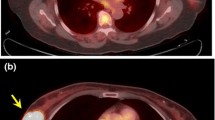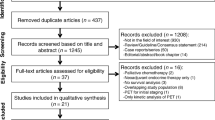Abstract
Clinical evidence regarding the value of 18F-FDG PET for therapy responses assessment in breast cancer is increasing. The objective of this study is to evaluate the accuracy of 18F-FDG PET in predicting responses to neoadjuvant therapies with meta-analysis and explore its optimal regimen for clinical use. Articles in English language relating to the accuracy of 18F-FDG PET for this utility were retrieved. Methodological quality was assessed by QUADAS tool. Pooled estimation and subgroup analysis data were obtained by statistical analysis. Nineteen studies met the inclusion criteria and involved 920 pathologically confirmed patients in total (mean age 49.8 years, all female). Methodological quality was relatively high. To predict histopathological response in primary breast lesions by PET, the pooled sensitivity, specificity, positive predictive value (PPV), negative predictive value (NPV), and diagnostic odds ratio were 84% (95% CI, 78–88%), 66% (95% CI, 62–70%), 50% (95% CI, 44–55%), 91% (95% CI, 87–94%), and 11.90 (95% CI, 6.33–22.36), respectively. In regional lymph nodes, sensitivity and NPV of PET were 92% (95% CI, 83–97%) and 88% (95% CI, 76–95%), respectively. Subgroup analysis showed that performing a post-therapy 18F-FDG PET early (after the 1st or 2nd cycle of chemotherapy) was significantly better than later (accuracy 76% vs. 65%, P = 0.001). Furthermore, the best correlation with pathology was yielded by employing a reduction rate (RR) cutoff value of standardized uptake value between 55 and 65%. 18F-FDG PET is useful to predict neoadjuvant therapy response in breast cancer. However, the relatively low specificity and PPV still call for caution. It is suggested to perform PET in an earlier course of therapy and use RR cutoff value between 55 and 65%, which might potentially identify non-responders early. However, further prospective studies are warranted to assess this regimen and adequately position PET in treatment management.




Similar content being viewed by others
Abbreviations
- 18F-FDG PET:
-
18F-fluor-18-deoxyglucose positron emission tomography
- NCT:
-
Neoadjuvant chemotherapy
- LABC:
-
Locally advanced breast cancer
- pCR:
-
Pathological complete response
- PPV:
-
Positive predictive value
- NPV:
-
Negative predictive value
- DOR:
-
Diagnostic odds ratio
- AUC:
-
Areas under the curves
- SUV:
-
Standardized uptake value
- RR:
-
Reduction rate
- SROC:
-
Summary receiver operating characteristic curves
- IDC:
-
Invasive ductal cancer
- ILC:
-
Invasive lobular cancer
- NSIBC:
-
Non-special invasive breast cancer
- MRD:
-
Minimal residual disease
- FNA:
-
Fine needle aspiration
- SNB:
-
Sentinel node biopsy
- DUR:
-
Dose uptake rate of FDG
- TBR:
-
Tumor to background ratio
- DFS:
-
Disease-free survival
References
Wolff AC, Davidson DN (2000) Primary systemic therapy in operable breast cancer. J Clin Oncol 18:1558–1569
Rastogi P, Anderson SJ, Bear HD, Geyer CE, Kahlenberg MS, Robidoux A, Margolese RG, Hoehn JL et al (2008) Preoperative chemotherapy: updates of National Surgical Adjuvant Breast and Bowel Project Protocols B-18 and B-27. J Clin Oncol 26:778–785
Norbert Avril SS, Roylance R (2009) Response to therapy in breast cancer. J Nucl Med 50:55–63
Wolmark N et al (2001) Preoperative chemotherapy in patients with operable breast cancer: nine-year results from National Surgical Adjuvant Breast and Bowel Project B-18. J Natl Cancer Inst Monogr 30:96–102
Rouzier R, Extra JM, Klijanienko J, Falcou MC, Asselain B, Vincent-Salomon A et al (2002) Incidence and prognostic significance of complete axillary downstaging after primary chemotherapy in breast cancer patients with T1 to T3 tumors and cytologically proven axillary metastatic lymph nodes. J Clin Oncol 20:1304–1310
Berriolo-Riedinger A, Touzery C, Riedinger JM, Toubeau M, Coudert B, Arnould L, Boichot C, Cochet A, Fumoleau P, Brunotte F (2007) [18F]FDG-PET predicts complete pathological response of breast cancer to neoadjuvant chemotherapy. Eur J Nucl Med Mol Imaging 34:1915–1924
Partridge SC, Gibbs JE, Lu Y, Esserman LJ, Sudilovsky D, Hylton NM (2002) Accuracy of MR imaging for revealing residual breast cancer in patients who have undergone neoadjuvant chemotherapy. AJR Am J Roentgenol 179:1193–1199
Straver ME, Aukema TS, Olmos RA, Rutgers EJ, Gilhuijs KG, Schot ME, Vogel WV, Peeters MJ (2010) Feasibility of FDG PET/CT to monitor the response of axillary lymph node metastases to neoadjuvant chemotherapy in breast cancer patients. Eur J Nucl Med Mol Imaging 37:1069–1076
Choi JH, Lim HI, Lee SK, Kim WW, Kim SM, Cho E, Ko EY, Han BK, Park YH, Ahn JS, Im YH, Lee JE et al (2010) The role of PET CT to evaluate the response to neoadjuvant chemotherapy in advanced breast cancer: comparison with ultrasonography and magnetic resonance imaging. J Surg Oncol 102:392–397
Rosen EL, Turkington TG, Soo MS, Baker JA, Coleman RE (2005) Detection of primary breast carcinoma with a dedicated, large-field-of-view FDG PET mammography device: initial experience. Radiology 234:527–534
Whiting P, Rutjes AW, Reitsma JB, Bossuyt PM, Kleijnen J (2003) The development of QUADAS: a tool for the quality assessment of studies of diagnostic accuracy included in systematic reviews. BMC Med Res Methodol 3:25
Higgins JP, Thompson SG, Deeks JJ, Altman DG (2003) Measuring inconsistency in meta-analyses. Brit Med J 327:557–560
Reitsmaa JB, Glas AS, Rutjes AW, Scholten RJ, Bossuyta PM, Zwindermana AH (2005) Bivariate analysis of sensitivity and specificity produces informative summary measures in diagnostic reviews. J Clin Epidemiol 58:982–990
Song F, Khan KS, Dinnes J, Sutton AJ (2002) Asymmetric funnel plots and publication bias in meta-analyses of diagnostic accuracy. Int J Epidemiol 31(1):88–95
Park JS, Moon WK, Lyou CY, Cho N, Kang KW, Chung JK (2011) The assessment of breast cancer response to neoadjuvant chemotherapy: comparison of magnetic resonance imaging and 18F-fluorodeoxyglucose positron emission tomography. Acta Radiol 52:21–28
Rousseau C, Devillers A, Campone M, Campion L, Ferrer L, Sagan C, Ricaud M, Bridji B, Kraeber-Bodéré F (2011) FDG PET evaluation of early axillary lymph node response to neoadjuvant chemotherapy in stage II and III breast cancer patients. Eur J Nucl Med Mol Imaging 38:1029–1036
Dose-Schwarz J, Tiling R, Avril-Sassen S, Mahner S, Lebeau A, Webe C, Schwaiger M, Ja¨nicke F, Untch M, Avril N (2010) Assessment of residual tumour by FDG-PET: conventional imaging and clinical examination following primary chemotherapy of large and locally advanced breast cancer. Br J Cancer 102:35–41
Jung SY, Ki-Kim S, Byung-Ho N, Min SY, Lee SJ, Park C, Kwon Y, Kim EA, Ko KL, Park IH, Lee KS, Shin KH et al (2010) Prognostic impact of [18F] FDG-PET in operable breast cancer treated with neoadjuvant chemotherapy. Ann Surg Oncol 17:247–253
Schneider-Kolsky ME, Hart S, Fox J, Midolo P, Stuckey J, Hofman M, Ganju V (2010) The role of chemotherapeutic drugs in the evaluation of breast tumour response to chemotherapy using serial FDG-PET. Breast Cancer Res 12:R37
Martoni AA, Zamagni C, Quercia S, Rosati M, Cacciari N, Bernardi A, Musto A, Fanti S, Santini D, Taffurelli M (2010) Early 18F-2-fluoro-2-deoxy-d-glucose positron emission tomography may identify a subset of patients with estrogen receptor-positive breast cancer who will not respond optimally to preoperative chemotherapy. Cancer 115:805–813
Ueda S, Tsuda H, Saeki T, Omata J, Osaki A, Shigekawa T, Ishida J, Tamura K, Abe Y, Moriya T, Yamamoto J (2010) Early metabolic response to neoadjuvant letrozole, measured by FDG PET/CT, is correlated with a decrease in the Ki67 labeling index in patients with hormone receptor-positive primary breast cancer: a pilot study. Breast Cancer. doi:10.1007/s12282-010-0212-y
Prati R, Minami CA, Gornbein JA, Debruhl N, Chung D, Pharm D, Chang HR (2009) Accuracy of clinical evaluation of locally advanced breast cancer in patients receiving neoadjuvant chemotherapy. Cancer 115:1194–1202
Kumar A, Kumar R, Seenu V, Gupta SD, Chawla M, Malhotra A, Mehta SN (2009) The role of 18F-FDG PET/CT in evaluation of early response to neoadjuvant chemotherapy in patients with locally advanced breast cancer. Eur Radiol 19(6):1347–1357
Dose-Schwarz J, Tiling R, Sassen S, Mahner S, Kahlert S, Harbeck N, Lebeau A, Brenner W, Schwaiger M, Jaenicke F, Avril N (2009) Monitoring primary systemic therapy of large and locally advanced breast cancer by using sequential positron emission tomography imaging with [18F] fluorodeoxyglucose. J Clin Oncol 27:535–541
McDermott GM, Welch A, Staff RT, Gilbert FJ, Schweiger L, Semple SI, Tim K, Smith AD, Hutcheon AW, Miller ID, Smith IC, Heys SD (2007) Monitoring primary breast cancer throughout chemotherapy using FDG-PET. Breast Cancer Res Treat 102:75–84
Rousseau C, Devillers A, Sagan C, Ferrer L, Bridji B, Campion L, Ricaud M, Bourbouloux E, Doutriaux I, Clouet M, Berton-Rigaud D, Bouriel C et al (2006) Monitoring of early response to neoadjuvant chemotherapy in stage II and III breast cancer by [18F] fluorodeoxyglucose positron emission tomography. J Clin Oncol 24:5366–5372
Kim SJ, Kim SK, Lee ES, Ro J, Kang Sh (2004) Predictive value of [18F]FDG PET for pathological response of breast cancer to neoadjuvant chemotherapy. Ann Oncol 15:1352–1357
Smith BC, Hutcheon AW, Miller ID, Payne S, Chilcott F, Waikar S, Whitaker T, Ah-See AK, Eremin O, Heys SD, Gilbert FJ et al (2000) Positron emission tomography using [18F]-fluorodeoxy-d-glucose to predict the pathologic response of breast cancer to primary chemotherapy. J Clin Oncol 18:1676–1688
Schelling M, Avril N, Na¨hrig J, Kuhn W, Ro¨mer W, Sattler D, Werner M, Dose J, Ja¨nicke F, Graeff H, Schwaiger M (2000) Positron emission tomography using [18F] fluorodeoxyglucose for monitoring primary chemotherapy in breast cancer. J Clin Oncol 18:1689–1695
Bassa P, Kim EE, Inoue T, Wong FC, Korkmaz M, Yang DJ, Wong WH, Hicks KW, Buzdar AU, Podoloff DA (1996) Evaluation of preoperative chemotherapy using PET with fluorine 18-fluorodeoxyglucose in breast cancer. J Nucl Med 37:931–938
Wahl RL, Jacene H, Kasamon Y, Lodge MA (2009) From RECIST to PERCIST: evolving considerations for pet response criteria in solid tumors. J Nucl Med 50:122S–150S
Weber WA (2009) Assessing tumor response to therapy. J Nucl Med 50:1S–10S
Young H, Baum R, Cremerius U, Herholz K, Hoekstra O, Lammertsma AA, Pruim J, Price P (1999) Measurement of clinical and subclinical tumour response using [18F]-fluorodeoxyglucose and positron emission tomography: review and 1999 EORTC recommendations. Eur J Cancer 35:1773–1782
Schott AF, Roubidoux MA, Helvie MA, Hayes DF, Kleer CG, Newman LA, Pierce LJ, Griffith KA, Murray S, Hunt KA et al (2005) Clinical and radiologic assessments to predict breast cancer pathologic complete response to neoadjuvant chemotherapy. Breast Cancer Res Treat 92:231–238
Emmering J, Krak NC, Van der Hoeven JJ, Spreeuwenberg MD, Twisk JW, Meijer S, Pinedo HM, Hoekstra OS (2008) Preoperative [18F] FDG-PET after chemotherapy in locally advanced breast cancer: prognostic value as compared with histopathology. Ann Oncol 19:1573–1577
Acknowledgement
The authors thank Dr. Gang Huang (Department of Nuclear Medicine, Renji Hospital, Shanghai Jiaotong University School of Medicine, Shanghai, China) for critical review and correction of the manuscript. The authors thank the funding below for supporting the work: National Natural Science Foundation of China, Project Number: 30830038, 81071180, 30970842; Shanghai Leading Academic Discipline Project, Project Number: S30203; Key Project of Science and Technology Committee of Shanghai, Project Number: 10JC1410000.
Conflicts of interest
None.
Author information
Authors and Affiliations
Corresponding author
Rights and permissions
About this article
Cite this article
Wang, Y., Zhang, C., Liu, J. et al. Is 18F-FDG PET accurate to predict neoadjuvant therapy response in breast cancer? A meta-analysis. Breast Cancer Res Treat 131, 357–369 (2012). https://doi.org/10.1007/s10549-011-1780-z
Received:
Accepted:
Published:
Issue Date:
DOI: https://doi.org/10.1007/s10549-011-1780-z




